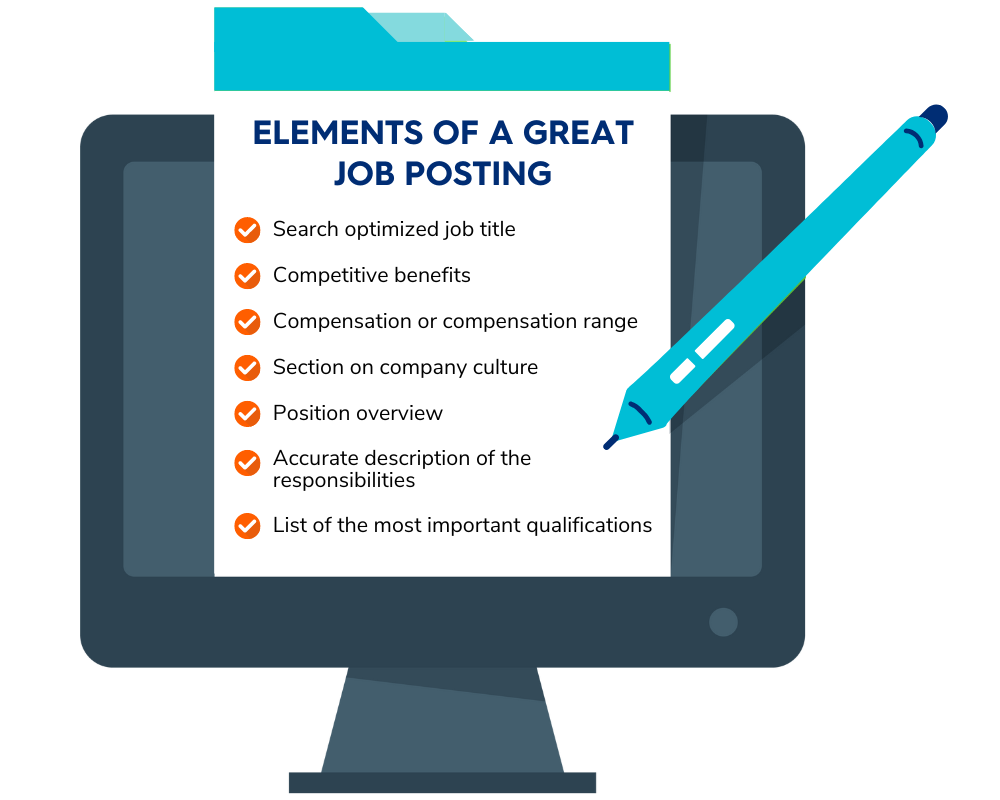Table of Contents
-
Use a job title that job seekers are searching for
-
Stand out from the crowd by leading with benefits
-
Include compensation or a compensation range
-
Highlight your company culture
-
Give an overview of the position
-
Accurately describe the responsibilities of the role
-
Include the most important qualifications
Your job posting is your first official gatekeeper, the first impression you make on job seekers, and the first step in finding a new member of your team. So you want your job description to be clear: here’s the job, here’s who we are, and here’s what we’re offering.
By writing a compelling and concise job posting, you’ll get those quality applicants through the door. If you’re too vague in the job post, you might get quantity, but not necessarily quality — which means you’ll just have more candidates to sort through who may not be qualified.
In this post, we’re sharing step by step instructions for writing a job posting that attracts and converts job seekers, and helps you make hires for your team.
Free job description templates
Fill out the form below to download free job description templates written by the Hiring Experts at CareerPlug. You’ll find job descriptions for common positions in a variety of industries.

Free Job Description Templates
Make writing your next job description quick and easy by using one these templates created by our Hiring Experts. Our job descriptions are created with best practices in mind to help you write a description that attracts and converts job seekers.
DOWNLOAD MY FREE TEMPLATESTips for writing a job posting
Use a job title that job seekers are searching for
This seems like a no-brainer, right? But there are best practices to keep in mind, even when writing something as basic as your job title.
Most importantly: make sure you choose a relevant job title. Avoid using quirky terms like “rockstar assistant” or “sales ninja” or “marketing guru.” Your job title should be something that the employee could put on a business card or LinkedIn profile.
Keep in mind what keywords applicants would use on search engines like Indeed and what job titles would sound more attractive. It’s important to optimize your job title for search because the title is what people will click!
Remember that there are certain practices that may cause job boards to flag your posting. Here are some tips to help keep your job title compliant with their rules:
- Avoid symbols
- Don’t use phrases to create urgency in the job title (like “Hiring ASAP”)
- Don’t use all caps
- Don’t list the dates/times of shifts in the title
- Avoid unnecessary descriptors in the title
Stand out from the crowd by leading with your benefits
In today’s competitive labor market, it no longer works for job descriptions to simply be a laundry list of requirements. If you really want to attract the most qualified candidates, you also need to use the job posting to do some selling and tell them why they should work for you. The best way to do this is to list the benefits and/or perks!
If your job is similar to those offered by your competitors, the benefits/perks you offer may swing a candidate in your direction. Also, your benefits may even generate more applicants for your company.
Here are some benefits you might want to include in the job posting if your company offers them:
- Health insurance
- 401K Matching
- Vacation rules – list this if you think your paid time off benefits are similar to or better than your competition
- Social events
- Free swag
- Discounts
- Free lunches
- Casual dress code
- Sponsored education
Include compensation or a compensation range
We recommend including the job’s compensation —or a compensation range —on the job posting. This sets expectations up-front and helps ensure that you receive applicants you can afford.
It wastes a lot of your time if you’re $50,000 off from a candidate’s expectations. Of course, it’s also appropriate to ask when interviewing, but you should include compensation in the job posting even if it’s just a wider range.
Including compensation in a job description also helps it show up in job board search results. On many job boards, job seekers can search for jobs within salary ranges. If you’ve entered your compensation range, your job is going to show up more appropriately. This can be a great tool for elevating the quality of applications you receive.
Highlight your company culture
Your job posting is essentially an advertisement, so use this as an opportunity to sell your company. If applicants find your job posting on a job board instead of your company’s website, you’ll want to sell them on who you are with a brief elevator pitch.
Craft your introduction to appeal to your target audience. Make sure to highlight core values, perks, and company culture but always be truthful in how you represent your company. Setting false expectations will prohibit you from finding a good fit.
Give an overview of the position
Keep it concise! This short job position description should be a high-level overview of what this role is all about, what impact they will have, what other teams or positions they are going to be working with, and what an ideal candidate would look like.
The key for this position description paragraph is leading with impact. Obviously things like benefits and compensation are very important for any job seeker, but people want to feel like what they’re doing matters, it has significance, and it’s valued at your company.
What metrics are they affecting? What clients are they taking care of? How are they going to matter at your organization? Sell them on that up front.
Here’s an example of a job position description for a server:
Servers bridge the kitchen and our guests, ensuring that the food is out and the guests at each table are happy. Our servers are always organized, calm, and friendly, going above and beyond to make sure their tables have the best experience.
Accurately describe the responsibilities of the role
Now that you’ve completed the company and job position overviews, it’s time to get into the details: the job responsibilities. When writing job responsibilities, focus on including as many essential details as possible.
Here are some tips to writing clear and comprehensive job responsibilities:
- Use action words: Words like provide, work with, prepare, and assist help candidates get a sense of what they will be doing on a day-to-day basis.
- Be detailed but not rigid: Unless a certain software or tool is absolutely necessary to use to complete a task, focus on telling candidates what they will be doing not how they will be doing it.
- Make sure expectations are clear: Consider including how often a task will be performed or what percentage of time employees should spend on tasks.
- Include company standards: Ensure the candidates you seek will be compliant with brand standards by including responsibilities that maintain the integrity of your product or service.
- Add skills when needed: If your job is highly technical, add phrases such as “use analytical skills” or “use critical thinking skills.”
While you want to be detailed about the responsibilities the job entails, you don’t want to list the entire scope of their job duties. Keep it concise. Seeing a list of 20 bullet items can be overwhelming for anyone. We recommend sticking to a list of 5-8 major responsibilities.
Include the most important qualifications
Qualifications can fall into two different categories: quantitative and qualitative. Quantitative qualifications include degrees, years of experience, industry knowledge, and the ability to perform certain skilled tasks. Qualitative qualifications, which can be just as important, include skills such as teamwork, time management, being friendly, or being optimistic.
As you decide which competencies and skills are necessary for your job, consider splitting them into two categories:
- Minimum qualifications: What is the degree, experience, or ability to perform a job needed at a minimum?
- Preferred qualifications: These are qualifications or skills and competencies that you would like to see in an ideal candidate, such as experience in a SaaS company.
Once you decide on your qualifications, try to offer alternate qualifications if possible. For instance, let’s say you are hiring for a General Manager at a franchise and you would like 10 years of experience managing in your industry. You might be willing to take on someone who has managed 15 years in another industry because they may not have the industry knowledge but they do have the management skills you require.
To sum it all up: Elements of a great job posting


You’ve learned the basics. Now take it a step further!
Why write a good job description when you can write a GREAT job description – one that helps you attract more and better candidates! We’re explaining everything you need to know in our Ultimate Guide to Effective Job Descriptions. Download your copy now.
GET MY E-BOOK


























